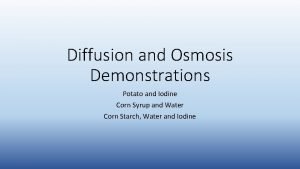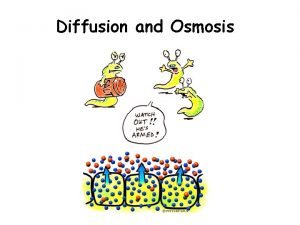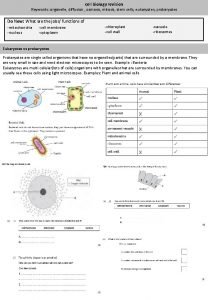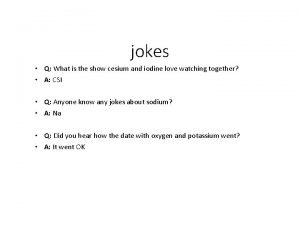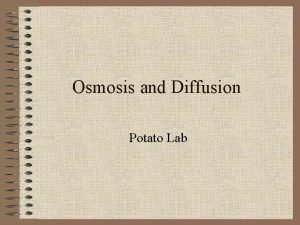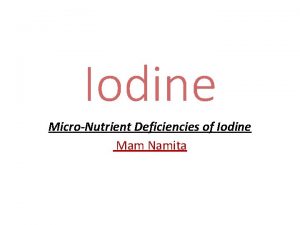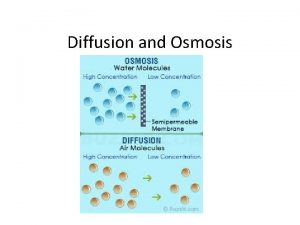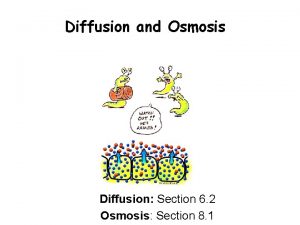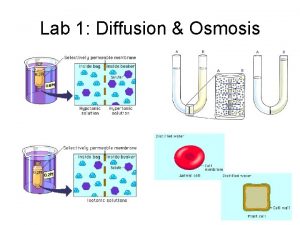Diffusion and Osmosis Demonstrations Potato and Iodine Corn













- Slides: 13

Diffusion and Osmosis Demonstrations Potato and Iodine Corn Syrup and Water Corn Starch, Water and Iodine

From left to right the concentration of Iodine increases in the graduated cylinders. The cubes are chunks of raw potato. The starch in the cells of the potato turns black when it is in contact with iodine.

We tested how far the iodine would diffuse into the potato and what difference the concentration made. The pictures show that in the same volume of solution for the same amount of time, the more concentrated the iodine was, the farther it traveled into the potato.

This principle is helpful when considering how to transfer a lot of solute quickly. The higher the concentration, the faster the saturation. This is why people with low Oxygen in their bodies breathe pure oxygen. The 100% oxygen from a tank diffuses faster into the tissue than the 20% oxygen in the air we breathe.

We use dialysis tubing to represent a semi-permeable membrane, one which allows some things to pass through, but not others.

We prepared a section of dialysis tubing filled with a 50/50 corn syrup and water solution. We measured the mass of the tube and then put it into a graduated cylinder filled with pure distilled water.

We waited for about 30 minutes before checking on the tube. After we took the tube out and dried it, we took the mass again. The tube was plump and had increased in mass by 9 grams. Based on this evidence, we claimed that water had entered the bag by osmosis. It went from a high concentration outside the bag to the low concentration inside the bag.

A tube of pure, distilled water was prepared using dialysis tubing. After measuring its mass, we put the tube of water into the beaker filled with corn syrup and water mixed together. We left the tube in the beaker for 30 minutes and then removed it and observed the changes.

The water tube was shriveled and had lost about 9 grams. We made the claim that water had moved out of the tube and into the corn syrup solution.

The evidence is the change in mass and appearance. The reason was that the water could pass through the spaces in the dialysis tubing by osmosis from high concentration to low concentration.

This dialysis tube has a mixture of Corn Starch and Water inside. We put the corn starch tube into the graduated cylinder containing a solution of water and iodine. We waited for about 30 minutes before checking on the tubes

The corn starch tube had turned purple inside but the water iodine solution had not changed. We also claimed that the iodine could move through the tubing membrane but the corn starch could not.

The iodine passed into the bag and reacted with the starch but no starch reacted in the graduated cylinder so it could not have passed through the membrane. If starch had left the tube, the iodine solution would have turned purplish black in color.
 Potato and iodine diffusion experiment
Potato and iodine diffusion experiment Receptor - mediated endocytosis
Receptor - mediated endocytosis Bulk transport homework
Bulk transport homework Types of diffusion
Types of diffusion Diffusion osmosis
Diffusion osmosis Determininants of the diffusion of hybrid corn
Determininants of the diffusion of hybrid corn Ornamental horticulture demonstrations ideas
Ornamental horticulture demonstrations ideas Political demonstrations on american campuses have abated
Political demonstrations on american campuses have abated Simple diffusion
Simple diffusion Relocation diffusion diagram
Relocation diffusion diagram What is the show cesium and iodine love watching
What is the show cesium and iodine love watching Redox volumetric analysis
Redox volumetric analysis Tincture of orange is prepared by which process
Tincture of orange is prepared by which process Chlorine, iodine, and _____ make up the halogen triad.
Chlorine, iodine, and _____ make up the halogen triad.
